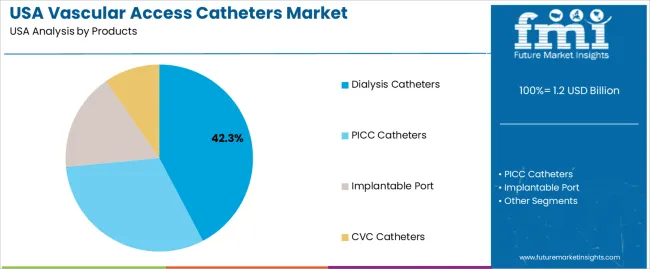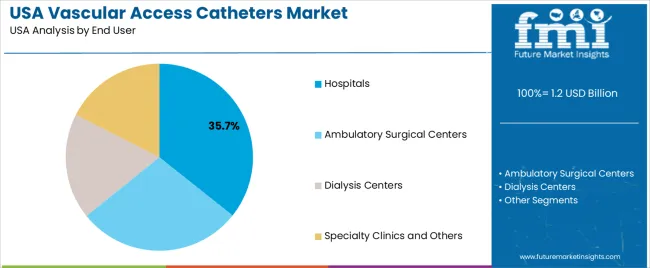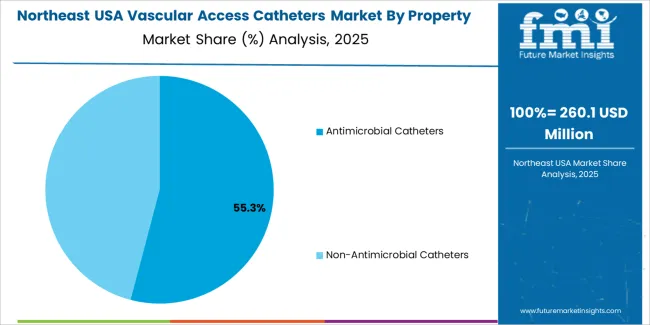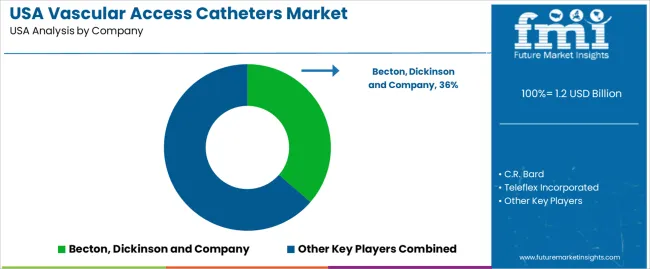The demand for vascular access catheters in the USA is expected to grow steadily, with a notable increase from USD 1.2 billion in 2025 to USD 2.1 billion by 2035. This growth reflects a compound annual growth rate (CAGR) of 5.40%. The demand for these catheters is driven by a variety of factors, including the growing need for medical procedures requiring vascular access, such as chemotherapy, dialysis, and long-term drug delivery. The increasing prevalence of chronic conditions like diabetes and kidney disease is expected to further fuel demand, as these conditions often require regular vascular access for treatments.
Vascular access catheters are essential medical devices used for easy and efficient administration of fluids, medications, or other treatments directly into the bloodstream. Their widespread usage in hospitals, clinics, and outpatient settings highlights their critical role in healthcare. As healthcare systems focus on improving patient outcomes, the demand for high-quality and reliable vascular access catheters will continue to rise. Moreover, technological advancements in catheter designs and materials, such as those aimed at improving comfort, reducing infection risks, and increasing ease of insertion, will contribute to the increasing demand for these devices.

From 2025 to 2026, demand is expected to grow from USD 1.2 billion to USD 1.3 billion, reflecting a modest yet steady increase. This growth can be attributed to the ongoing rise in the number of procedures requiring vascular access, driven by both an aging population and advancements in medical treatments. The healthcare sector’s continued focus on improving patient care and minimizing procedure-related complications will further support the demand for vascular access catheters.
The period between 2026 and 2027 will see a similar trend, with demand increasing from USD 1.3 billion to USD 1.4 billion. As more healthcare facilities implement advanced technologies and expand their vascular access services, the need for high-performance catheters will grow. By 2028, demand is expected to reach USD 1.5 billion, driven by further increases in the use of vascular access for chemotherapy, dialysis, and critical care procedures. This growth will continue steadily through 2035, with demand reaching USD 2.1 billion.
The expected year-on-year growth between 2029 and 2030, from USD 1.7 billion to USD 1.8 billion, will likely be influenced by the growing use of catheter-based technologies in outpatient and long-term care settings. The trend of increasing patient mobility and home-based healthcare solutions will also drive demand. As innovations in catheter design and safety features make these devices even more efficient and patient-friendly, healthcare providers will continue to prioritize their usage.
| Metric | Value |
|---|---|
| Demand for Vascular Access Catheters in USA Value (2025) | USD 1.2 billion |
| Demand for Vascular Access Catheters in USA Forecast Value (2035) | USD 2.1 billion |
| Demand for Vascular Access Catheters in USA Forecast CAGR (2025 to 2035) | 5.40% |
The demand for vascular access catheters in the USA is rising as the need for long‑term intravenous therapies increases, particularly in treatments such as chemotherapy, parenteral nutrition, and complex infusion therapies. The growing aging population, along with the increasing prevalence of chronic diseases like diabetes and cancer, is driving higher demand for these devices. Hospitals, outpatient centers, and home‑care providers are increasingly investing in catheter systems that provide extended vascular access, minimizing the frequency of re‑insertions and improving patient comfort.
Advancements in catheter design are also contributing to the rise in demand. Modern catheters feature improvements such as antimicrobial coatings, ultrathin walls for better flow, and securement systems that reduce the risk of displacement and complications like infections and thrombosis. These innovations help ensure greater safety and functionality, making the devices more attractive to healthcare providers.
Another significant factor driving the demand is the shift towards outpatient and home‑based care. As more treatments move outside traditional hospital settings, there is a greater need for catheters designed for longer‑term use, comfort, and minimal disruption to daily life. Home healthcare solutions, which require reliable vascular access devices, are becoming more prevalent, and catheters that meet these needs are in increasing demand. As the healthcare landscape continues to evolve, the demand for vascular access catheters in the USA is expected to continue growing steadily through 2035, driven by both technological advancements and changing treatment models.
Demand for vascular access catheters in the USA is segmented by product type, end user, property, and design. By product type, demand is divided into dialysis catheters, PICC catheters, implantable ports, and CVC catheters. The demand is also segmented by end user, including hospitals, ambulatory surgical centers, dialysis centers, and specialty clinics. In terms of property, demand is divided into antimicrobial and non-antimicrobial catheters. Regarding design, demand is divided into single lumen, double lumen, and multiple lumen. Regionally, demand is divided into West USA, South USA, Northeast USA, and Midwest USA.

Dialysis catheters account for 42% of the demand for vascular access catheters in the USA. These catheters are crucial for patients with chronic kidney disease (CKD) and end-stage renal disease (ESRD), providing a safe and effective method for dialysis, where waste and excess fluids are removed from the body. As the prevalence of CKD continues to increase, so does the need for dialysis treatments, driving the demand for dialysis catheters. These catheters are designed for long-term use, offering durability and reliability, which is essential for patients undergoing regular dialysis. They provide the required flow rates and can be used for extended periods, making them ideal for patients in need of chronic dialysis. With the rising number of kidney disease cases and increased awareness about dialysis treatments, the demand for dialysis catheters is expected to continue growing, maintaining their dominant position in the vascular access catheter industry.

Hospitals account for 36% of the demand for vascular access catheters in the USA. Hospitals serve as the primary healthcare setting for critically ill patients who require vascular access for a variety of medical procedures, such as dialysis, chemotherapy, or fluid and medication administration. These facilities have a high patient turnover and diverse medical needs, requiring a constant supply of vascular access catheters. Hospitals also have the infrastructure, specialized medical staff, and equipment necessary to handle complex cases, making them the largest users of these catheters. With a growing emphasis on critical care and an increasing number of hospital admissions, hospitals continue to play a significant role in the demand for vascular access catheters. As the healthcare sector expands, and more patients require intensive care, the role of hospitals in maintaining the demand for these essential medical devices will remain crucial, ensuring their leading share of the industry.
Key drivers include the rising incidence of chronic diseases (e.g., cancer, cardiovascular disease, renal failure) requiring prolonged intravenous access, an increase in surgical and outpatient procedures, a shift toward home‑infusion and ambulatory care settings, and advancements in catheter materials/coatings (e.g., antimicrobial, antithrombotic) and placement guidance (e.g., ultrasound, sensor‑enabled). Restraints include the high cost of advanced catheter systems, risks of catheter-related bloodstream infections (CRBSIs) and thrombosis, regulatory complexity, and the need for skilled clinicians for safe insertion and maintenance.
Why is Demand for Vascular Access Catheters Growing in USA?
In USA, demand for vascular-access catheters is increasing due to an ageing population that has a higher prevalence of chronic diseases such as cancer, cardiovascular conditions, and renal failure, requiring prolonged intravenous access. With more patients needing long-term treatment like chemotherapy, dialysis, and parenteral nutrition, the need for reliable vascular access is growing. Healthcare delivery is shifting towards outpatient, ambulatory, and home-care settings, leading to increased demand for extended-dwell catheters and midline catheters, which help reduce hospital stays and associated costs. Technological improvements have further driven demand by improving safety and reducing complications, making vascular access catheters more reliable for use in both acute-care settings and home environments. This shift is further supported by advancements in catheter coatings, insertion tools, and sensor integration for enhanced patient care.
How are Technological Innovations Driving Growth of Vascular Access Catheters in USA?
Technological innovations are significantly influencing the adoption of vascular access catheters in USA by improving their safety, usability, and functionality. Key advancements include the development of antimicrobial and antithrombogenic coatings that reduce the risks of infections and clot formation, thus enhancing patient outcomes. Ultrasound-guided catheter placement systems are making insertion procedures more accurate and reducing complications. Extended-dwell peripheral and midline catheters are emerging as alternatives to central venous catheters for long-term therapies, reducing patient discomfort and hospital stay times. The integration of sensors into catheters for real-time monitoring of flow and pressure is improving clinical decision-making. Innovations tailored for outpatient and home infusion environments are allowing for better patient care outside traditional hospital settings. Together, these advancements are helping to drive the broader adoption of vascular access catheters.
What are the Key Challenges Limiting Adoption of Vascular Access Catheters in USA?
A challenge is the cost of advanced vascular access catheters, as those with specialized features like antimicrobial coatings, sensors, and enhanced materials are more expensive than traditional versions. Another issue is reimbursement delays or limitations, particularly for outpatient and home-care settings, which can slow adoption of newer technologies. Clinical risks, including catheter-related bloodstream infections and thrombosis, remain a concern, requiring careful monitoring and skilled insertion. Regulatory complexities and lengthy approval processes for new devices hinder the availability of innovations in the industry. For certain treatments or short-term uses, simpler catheter systems may suffice, limiting the uptake of more advanced options in less critical care settings.

| Region | CAGR (%) |
|---|---|
| West | 6.2 |
| South | 5.6 |
| Northeast | 5.0 |
| Midwest | 4.3 |
The demand for vascular access catheters in the USA is increasing across all regions, with the West leading at a 6.2% CAGR. This growth is driven by advancements in healthcare infrastructure and the increasing need for precise and reliable medical devices. The South follows with a 5.6% CAGR, supported by the region's growing healthcare facilities and a rising number of medical procedures. The Northeast shows a 5.0% CAGR, fueled by high demand in urban healthcare centers and medical research institutions. The Midwest experiences moderate growth at 4.3%, with the rise of healthcare awareness and improved medical services contributing to the demand.

The West is experiencing the highest demand for vascular access catheters in the USA, with a 6.2% CAGR. This growth is primarily driven by the region's robust healthcare system, with cities like Los Angeles, San Francisco, and Seattle being hubs for medical advancements and clinical research. The West is home to cutting-edge medical institutions and a significant number of hospitals that rely on vascular access catheters for a variety of treatments. As medical procedures become more complex and patient care becomes more sophisticated, the demand for precise and reliable vascular access catheters has increased.
The West is witnessing a growing focus on improving patient care, with healthcare providers emphasizing the need for high-quality medical devices. The region’s advanced medical technologies and innovation in healthcare practices have contributed significantly to the growing use of vascular access catheters. With increased investments in healthcare infrastructure and a rising aging population, the West is positioned to see continued growth in the demand for these essential medical devices.
The South is experiencing significant growth in demand for vascular access catheters, with a 5.6% CAGR. This growth is largely driven by the expansion of healthcare facilities in states like Texas, Florida, and Georgia, where access to medical care and advanced procedures is improving. With a large and diverse population, the region is seeing a rise in medical procedures that require vascular access catheters, such as dialysis, intravenous therapy, and long-term medication administration.
The increasing availability of specialized healthcare providers and hospitals, along with the growing awareness of the benefits of vascular access catheters for patient care, is driving this demand. Furthermore, the region’s emphasis on improving healthcare outcomes and expanding medical services is contributing to the uptake of these devices. As the South continues to develop its healthcare infrastructure, the demand for vascular access catheters is expected to grow steadily.

The Northeast is experiencing steady growth in demand for vascular access catheters, with a 5.0% CAGR. The region’s growth is driven by the concentration of major urban healthcare centers, such as New York City and Boston, where advanced medical procedures and research are prevalent. High levels of healthcare spending and ongoing improvements in medical technology are pushing the demand for vascular access catheters as healthcare professionals increasingly rely on them for a variety of treatments.
The region’s focus on patient care and the rising need for specialized medical devices in urban healthcare systems are major factors contributing to the growing demand. As more hospitals and medical institutions adopt the latest technologies and techniques, the use of vascular access catheters is expected to continue expanding in the Northeast, supported by strong healthcare infrastructure and increasing healthcare needs in major cities.
The Midwest is experiencing moderate growth in demand for vascular access catheters, with a 4.3% CAGR. This growth is largely driven by improvements in the region's healthcare services and the rising number of medical procedures requiring vascular access. Major cities like Chicago and Detroit have been at the forefront of this shift, with hospitals and clinics increasingly adopting advanced medical devices to meet growing patient needs.
Although the growth rate is slower than in other regions, the Midwest's healthcare sector is gradually recognizing the importance of reliable and efficient medical devices, such as vascular access catheters, to improve patient outcomes. With increasing investments in healthcare infrastructure and a growing aging population, the demand for vascular access catheters is expected to rise, providing support for continued growth in the region.

The demand for vascular access catheters in the USA is served by several major companies. Becton, Dickinson and Company (BD) is the clear leader, holding estimated share of approximately 36.4 %. Other significant players active in the space include C.R. Bard, Teleflex Incorporated, and B. Braun Melsungen AG. The structure of the competitive field features strong portfolios, frequent product innovation, and considerable presence of global‑multinational manufacturers operating in the USA.
In this environment BD’s leadership comes from its broad portfolio of vascular access devices, regulatory‑compliance track record, and strong USA sales infrastructure. The other vendors differentiate themselves through specialty catheter features (for example antimicrobial coatings, multi‑lumen designs, or pressure‑monitoring capability), service offerings such as training or maintenance, and focus on niche segments (e.g., oncology infusion, dialysis access). Smaller or niche vendors face pressure from cost competition, regulatory entry barriers, reimbursement constraints, and the effectiveness of incumbent sales and distribution networks.
The competitive pressures in the USA include pricing and contracting with hospitals and ambulatory surgical centres, regulatory compliance (e.g., with the Food and Drug Administration), product recalls or safety concerns, and the necessity of continual innovation. The high share held by BD suggests that new entrants must offer compelling technological or cost advantages to gain meaningful traction.
| Items | Values |
|---|---|
| Quantitative Unit | USD billion |
| Product Type | Dialysis Catheters, PICC Catheters, Implantable Port, CVC Catheters |
| Property | Antimicrobial Catheters, Non-Antimicrobial Catheters |
| Design | Single Lumen, Double Lumen, Multiple Lumen |
| End User | Hospitals, Ambulatory Surgical Centers, Dialysis Centers, Specialty Clinics and Others |
| Regions Covered | West USA, South USA, Northeast USA, Midwest USA |
| Key Players Profiled | Becton, Dickinson and Company, C.R. Bard, Teleflex Incorporated, B. Braun Melsungen AG |
| Additional Attributes | Dollar sales by product type, property, design, end-user distribution, and regional trends, focusing on hospitals, surgical centers, and dialysis centers. Insights into demand across different product types and applications with special attention to antimicrobial options and various catheter designs. |
The demand for vascular access catheters in usa is estimated to be valued at USD 1.2 billion in 2025.
The market size for the vascular access catheters in usa is projected to reach USD 2.1 billion by 2035.
The demand for vascular access catheters in usa is expected to grow at a 5.4% CAGR between 2025 and 2035.
The key product types in vascular access catheters in usa are dialysis catheters, picc catheters, implantable port and cvc catheters.
In terms of property, antimicrobial catheters segment is expected to command 53.1% share in the vascular access catheters in usa in 2025.






Our Research Products

The "Full Research Suite" delivers actionable market intel, deep dives on markets or technologies, so clients act faster, cut risk, and unlock growth.

The Leaderboard benchmarks and ranks top vendors, classifying them as Established Leaders, Leading Challengers, or Disruptors & Challengers.

Locates where complements amplify value and substitutes erode it, forecasting net impact by horizon

We deliver granular, decision-grade intel: market sizing, 5-year forecasts, pricing, adoption, usage, revenue, and operational KPIs—plus competitor tracking, regulation, and value chains—across 60 countries broadly.

Spot the shifts before they hit your P&L. We track inflection points, adoption curves, pricing moves, and ecosystem plays to show where demand is heading, why it is changing, and what to do next across high-growth markets and disruptive tech

Real-time reads of user behavior. We track shifting priorities, perceptions of today’s and next-gen services, and provider experience, then pace how fast tech moves from trial to adoption, blending buyer, consumer, and channel inputs with social signals (#WhySwitch, #UX).

Partner with our analyst team to build a custom report designed around your business priorities. From analysing market trends to assessing competitors or crafting bespoke datasets, we tailor insights to your needs.
Supplier Intelligence
Discovery & Profiling
Capacity & Footprint
Performance & Risk
Compliance & Governance
Commercial Readiness
Who Supplies Whom
Scorecards & Shortlists
Playbooks & Docs
Category Intelligence
Definition & Scope
Demand & Use Cases
Cost Drivers
Market Structure
Supply Chain Map
Trade & Policy
Operating Norms
Deliverables
Buyer Intelligence
Account Basics
Spend & Scope
Procurement Model
Vendor Requirements
Terms & Policies
Entry Strategy
Pain Points & Triggers
Outputs
Pricing Analysis
Benchmarks
Trends
Should-Cost
Indexation
Landed Cost
Commercial Terms
Deliverables
Brand Analysis
Positioning & Value Prop
Share & Presence
Customer Evidence
Go-to-Market
Digital & Reputation
Compliance & Trust
KPIs & Gaps
Outputs
Full Research Suite comprises of:
Market outlook & trends analysis
Interviews & case studies
Strategic recommendations
Vendor profiles & capabilities analysis
5-year forecasts
8 regions and 60+ country-level data splits
Market segment data splits
12 months of continuous data updates
DELIVERED AS:
PDF EXCEL ONLINE
Vascular Access Catheters Market - Growth & Forecast 2025 to 2035
Neurovascular Access Catheters Market
Demand for Vascular Access Catheters in Japan Size and Share Forecast Outlook 2025 to 2035
Vascular Access System Market Size and Share Forecast Outlook 2025 to 2035
USA Mobile Phone Accessories Market Report – Growth, Innovations & Industry Trends 2025-2035
USA Hunting Equipment & Accessories Market Trends, Growth and Forecast 2025 to 2035
Demand for Cardiovascular Ultrasound in USA Size and Share Forecast Outlook 2025 to 2035
Demand for Cardiovascular Repair & Reconstruction Devices in USA Size and Share Forecast Outlook 2025 to 2035
Vascular Sheath Group Market Size and Share Forecast Outlook 2025 to 2035
Vascular Patches Market Forecast and Outlook 2025 to 2035
Access Control as a Service Market Size and Share Forecast Outlook 2025 to 2035
USA Medical Coding Market Size and Share Forecast Outlook 2025 to 2035
USA Labels Market Size and Share Forecast Outlook 2025 to 2035
USA Plant-based Creamers Market Size and Share Forecast Outlook 2025 to 2035
USA Barrier Coated Paper Market Size and Share Forecast Outlook 2025 to 2035
USA Electronic Health Records (EHR) Market Size and Share Forecast Outlook 2025 to 2035
USA Animal Model Market Size and Share Forecast Outlook 2025 to 2035
USA and Canada Packer Bottle Market Size and Share Forecast Outlook 2025 to 2035
USA Stretch Hood Films Market Size and Share Forecast Outlook 2025 to 2035
USA and Canada Fence Screen Market Size and Share Forecast Outlook 2025 to 2035

Thank you!
You will receive an email from our Business Development Manager. Please be sure to check your SPAM/JUNK folder too.
Chat With
MaRIA